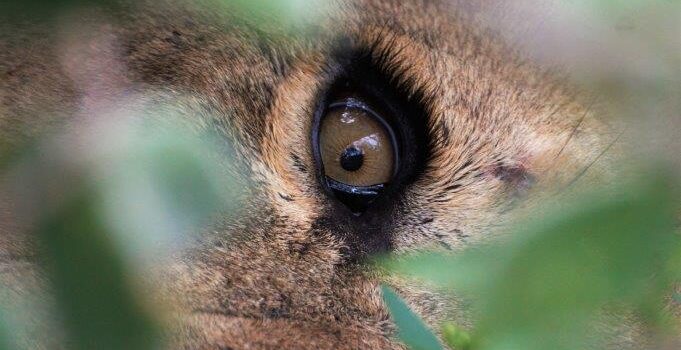Safari Game Drive – What We See Depends on What We Look For
Seeing is believing or perhaps seeing is deceiving.
The idea that seeing is believing dates to ancient Greece, from where the expression became part of many proverbs in English and other languages. The idea that we need to see something first, before believing it exists, may well be true, but sometimes what we see is not what we believe or hope it would be – especially on safari game drive. The eyes and the brain work together to visually perceive and interpret our surrounding environment. Would we ever be able to see the world through the eyes of others, other than our own?
A favourite story of mine, one of the real-life adventures of the early days of the Kruger National Park, told by Ranger Tomlinson, is both thrilling and frightening and quite assuredly indicates how the eyes deceive the brain or vice versa. In the collection of stories compiled by the author and photographer, C.P. de Leeuw Beyers, Ranger Tomlinson describes this encounter to us.
Its 1926, Ranger Tomlinson, stationed at Malelane in the southernmost regions of the recently established Kruger National Park, sets out with two African assistants to address recent reports of increased poaching in the Bumi spruit area. Shortly before sunset, they pack their provisions into the small Ford truck and head out to the area of concern. It was well known that poachers crossed the Crocodile River into the Kruger National Park under the cover of darkness, navigating their way through the reedbeds in the shallows of the river, taking care to avoid the deeper, crocodile-filled pools.
As it was late afternoon, Tomlinson decided to set Camp, from where they would continue to investigate the following morning. The small clearing they chose to Camp in was surrounded by dense bush so as not to give their presence away. Thinking of moving off early the next morning, Tomlinson chose to sleep in his cot next to his truck. The idea was to catch the meat poacher’s red-handed when crossing back over the Crocodile river in the early morning, with their meat carcasses in hand. Before giving his men permission to spend the night at a nearby picket (small ranger outpost) with friends, he asked they gather a bundle of firewood and place it 10 yards to the right of the front of his vehicle. They did so, made a small fire, boiled water for him for his tea, his personal assistant tending to his sleeping cot, before they headed off. It was overcast and late and they did not want to finish the trip on foot to the picket through lion-infested country in the dark.
Tomlinson settled into Camp, attended to his rifle, placing it upright against the front mudguard close to his cot. He placed his knife on the bonnet and went to pour his cup of tea. Not finding a teaspoon for his sugar, he recalled his knife on the bonnet. Stretching his hand out to the knife, he noted a dark form about 4 yards from him. Without any star or moonlight, it was difficult to make out the shape, but he remembered the bundle of firewood. Within a few seconds he recalled that the bundle had been placed to the right of the truck and at that moment, he could faintly discern the outline of a male lion. He was crouched low, flat against the ground with his chin just above his forepaws. Tomlinson slowly reached for his rifle and attempted to push a cartridge into it, jamming it in his heightened state of mind. He quickly lifted both arms and rifle above his head, shouting profanity at the Male lion, which leapt up and immediately bounded out of sight. Tomlinson quickly found his way into the truck and switched on the headlights. Within the welcoming beams of light, he could make out 12 adult lions within about 15 paces of his camp! Of the night that remained ahead of him, Tomlinson recalls “It was the only time in the veld that I can remember sleeping in my vehicle and not next to it on my camp stretcher”.
I am often asked what we look for when we head out on a safari game drive and the question is directed more at how we look than what we look for. Spending time out on the reserve daily gives us the ‘home ground’ advantage in that we know where we should be looking but we have also familiarised ourselves with the lay of the land. To answer the question though in HOW we look, we simply look for change: in shape, colour contrast, change in appearance etc. etc.
There is a tree stump in the Camp that catches your eye as you walk out of the Main Lodge. It is part of a dead tree that was extirpated by an elephant some time ago. This stump at night in the sweeping beam of torchlight looks just like a large owl sitting on the horizontal of the now-dead tree. It has for the past 4 years caused me to double-take when I see it, although I have seen it countless times before. It is quite obviously there during the day, but we pay no attention to it, nor does it strike us to resemble an owl, as we would quite simply not see an owl during the day sitting out in the open. This contradicts what I stated earlier, in how we look when we look for what we are looking for! The point is that, just as Tomlinson was looking at a male lion as a bundle of wood, the opposite holds true in my tree owl case. When we escort Guests back to rooms at night, given that the Camp is unfenced, we are alert and more aware of what changes we may see or what potential animals we may encounter. The fact that it is night and we lack sufficient vision in the dark, limited to the scope of the torches’ beam, makes us more aware and so the Owl tree comes alive.
For most people who visit Makweti Safari Lodge and embark on their first safari game drive, tuning into this environment takes a little time, a day or two. Think of the city you live and work in. Going to work each day in a somewhat predetermined routine to avoid traffic, attend meetings and beat the clock. Signs, lights, billboards, movements, cars, signals, and noise all bombard your senses and brain. With time your brain shuts out those irrelevant and you simply stop looking at the billboard advertisement you pass by every morning at roughly the same time. Should a new advertising banner replace it though, you will notice it immediately. This is what we look for, the change!
It is important to note before continuing that the point is actually not to be seen, and so animals have adopted ways to conceal themselves, either through behaviour or physiological development and changes in their growth stages, but mostly by virtue of millennia of genetic modifications with only the best reliable traits sticking around.
Colour vs Light
As much as colour, shape, light, and movement dominate our vision, so too do they for mammals, although in different ways. Sight is made possible for most mammals because of several factors. Put simply, for them to see, light must enter the eye and be bent or ‘refracted’ onto the Retina, at the back of the eye. Light enters the eye through the lens, which helps refract light and provides clarity for the object being seen. This light is then picked up by the photo-receptor cells on the Retina. These light-sensitive cells, known as the Rods and Cones, provide information to the brain which in turn interprets this information into the image of the object being seen. Rods are receptive to light where the Cone cells are receptive to colour.
Most mammals are colour-blind. They see a limited number of colours like what some colour-blind humans would see. Humans have trichromatic colour vision; we have three cell types in our eye that absorb the colours blue, green and red. Most other mammals have only two cell types that absorb only two colours in different fractions of light and colour. Most of these have cells that absorb green and blue colours predominantly, or shades of yellow and grey. The reduced number of colour cells in the Retina lends itself to having more light-sensitive cells in the Retina, the Rods, which aid in seeing better in dim light conditions. This also allows them to see colours better in dim light. Most Humans are colour-blind in dim light conditions. Humans, apes, many species of birds and fish, and squirrels have well-developed colour vision. Most other mammals have limited colour vision, including dogs.
Light is equally important as is the overall field of vision. Most mammals make up for the lack of colour vision in being able to see far better in dim light and with a wider field of vision than humans.
What we see while on safari game drive, with birds seeing in an array of colours, it’s no wonder that some are the most spectacular colours and why colour plays an important role for them in courting or finding food. Even in an African bushveld environment where colour can sometimes be limited, birds such as the Little Bee-eater stand out splendidly.

The colours of animals certainly assist them in concealing themselves and this is critically linked to behaviour, particularly in the Savannah environment, where competition and predation are paramount. Even in birds, in early stages of development, muted colours to blend into their environment is important. The colour of an Ostrich chick about 4 weeks old, is vastly different from the adults; however, the colouration aids with concealment when laying still in a tuft of grass is critical for survival.
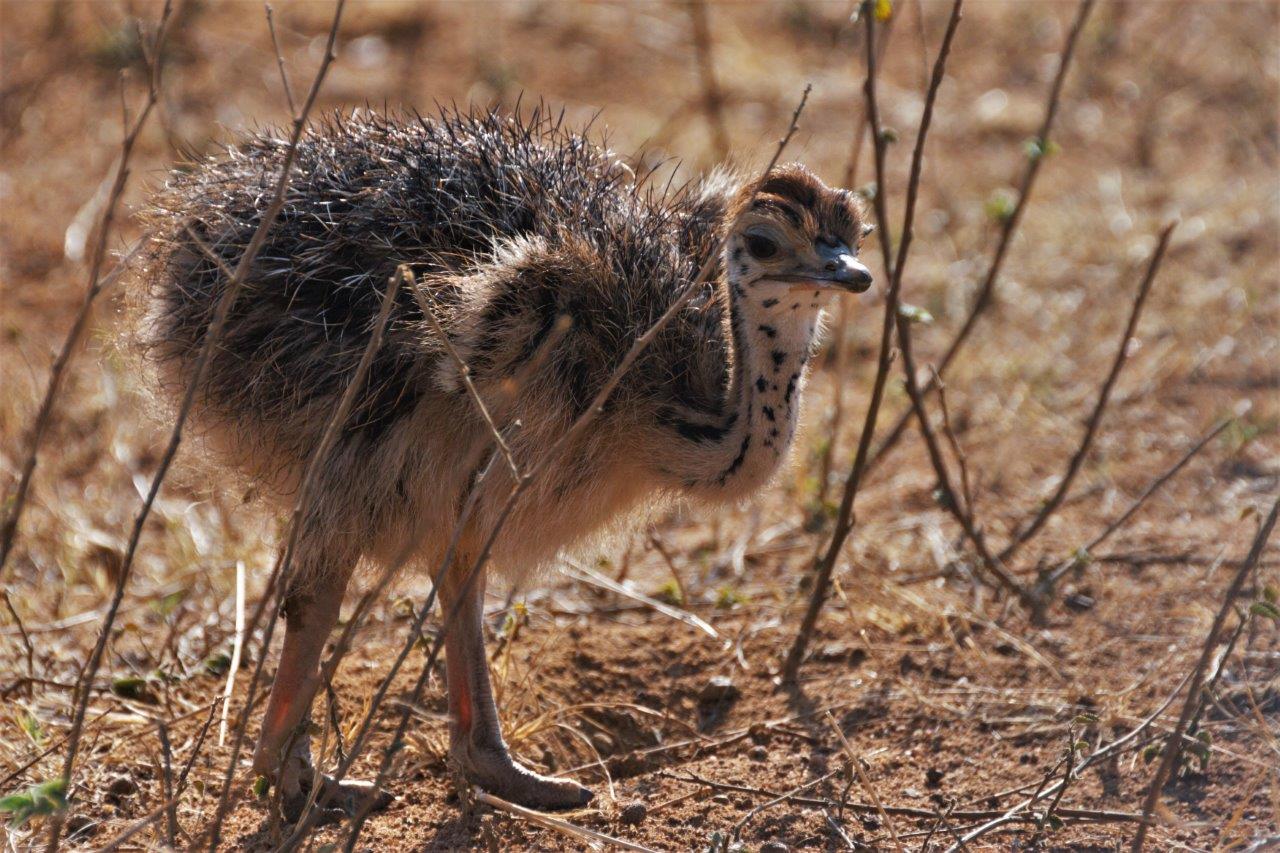
Night Vision
It’s certainly no secret that without additional light we simply cannot navigate in the dark. Without a torch, we would never see the Owl tree stump in the Camp at night. Seeing colour in triple is advantageous for us during daylight, however, it renders us rather weak at night. Mammals have the upper hand here and are well suited to survival with their enhanced night vision. Predators such as Lion, Leopard and Hyena, most active at night, may have limited colour vision but have the adaptations which make them powerful operators in the dark. Lion and Leopard have clear white patches under the eye which assist in reflecting as much ambient light for the eye to get a clearer and more illuminated look at the animals surrounds. The image of the lioness in the grass clearly shows these white patches under the eyes.
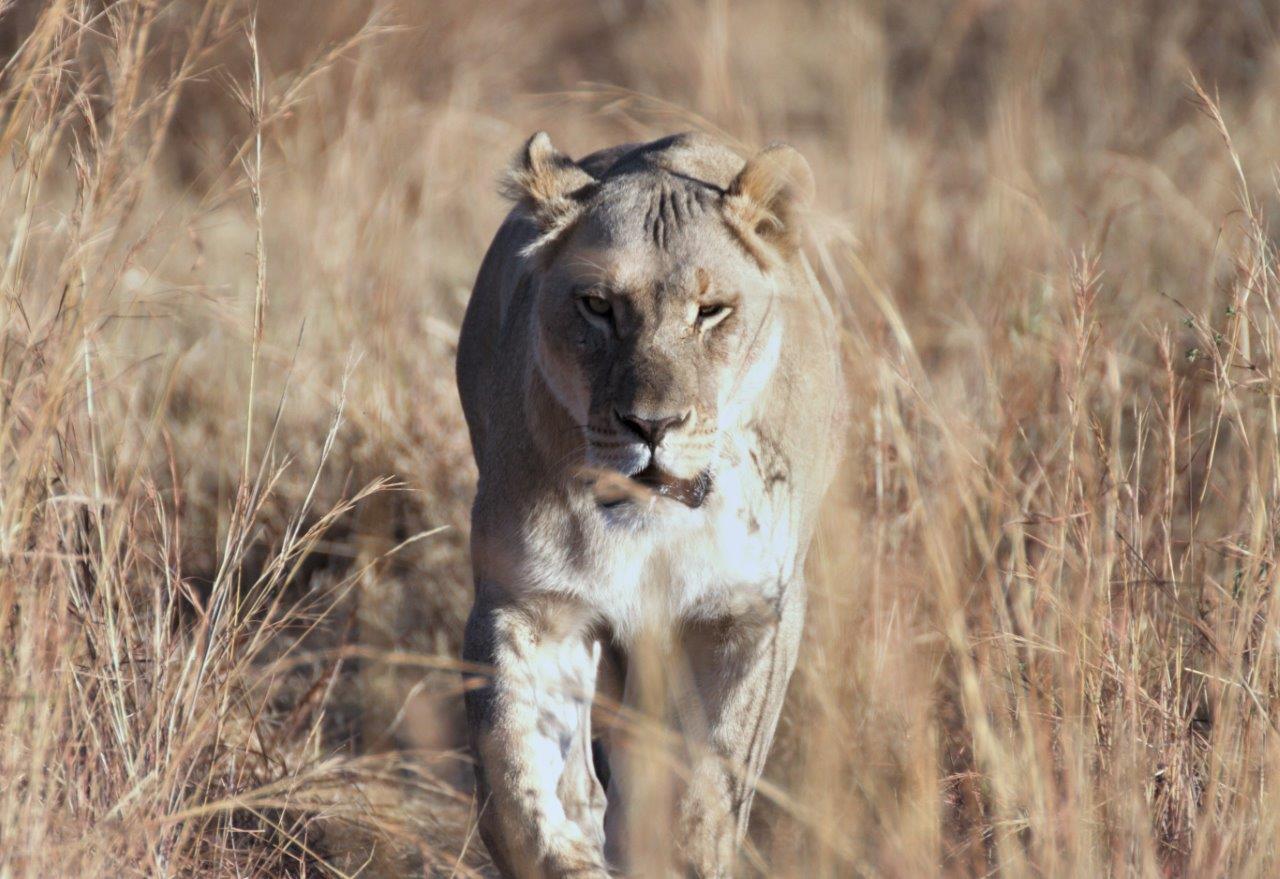
A unique added advantage for nocturnal mammals is the presence of a layer of mirror-like cells which is found behind the retina on the inside of the eye. This reflective layer gives the appearance that nocturnal mammals have eyes that ‘glow in the dark’. This is referred to as eyeshine. The layer of reflective cellular crystals at the back of the eye is called the tapetum lucidum. The light that passes through the cells of the retina (rods and cones) hit this crystal layer and is then reflected back through these cells giving the brain a second opportunity to refine the image from which the light is coming from. This is a rather simple description of this process which is quite diverse in composition. The tapetums generally occupy the upper half of the retina to collect and enhance the visual cues from the darker ground. The lower half of the retina is occupied by darkly pigmented cells, called the tapetum nigrum, which subdues light from the brighter sky.
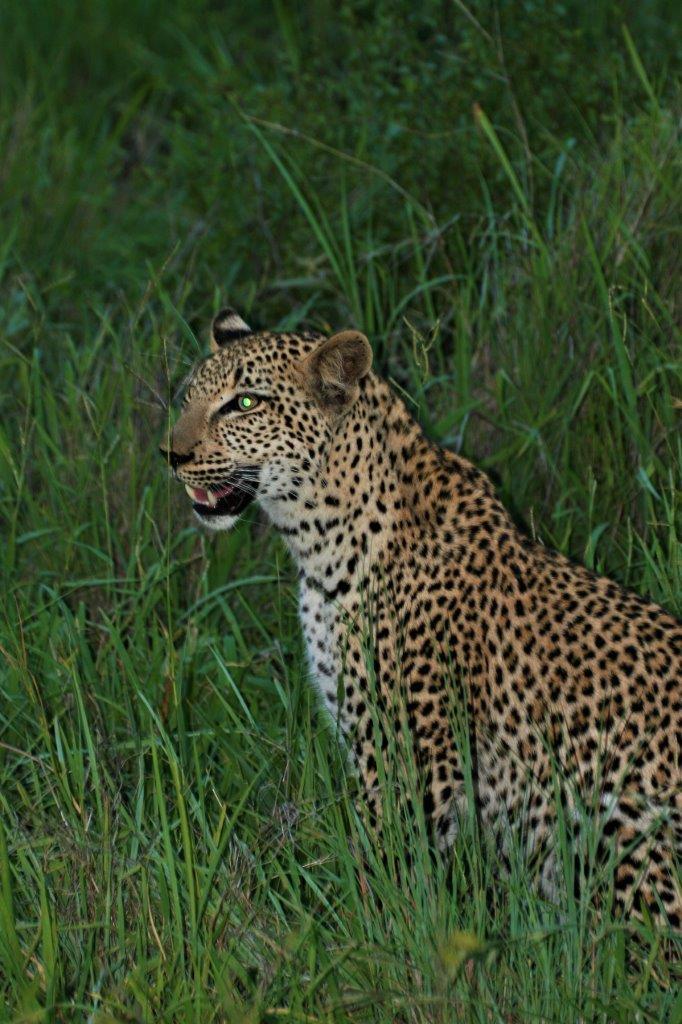
The image of the Leopard was taken in the early evening at around 6pm in summer, while on safari game drive. This is a particularly difficult time of the day for us to see clearly, although in summer it is slightly easier with a more colourful background. With a spotlight shining near the Leopard, but not directly on it, the eyeshine is clear, with the reflected light from the tapetum lucidum, escaping through the Retina and exiting the eye. The colour of the eyeshine is not necessarily animal specific although animals with larger pupils, tend to have more reddish eyeshine because of the increased in blood supply to the Retina, giving the eyeshine its orange, red appearance.
Rhino and Elephant do not have any eyeshine, as a result of their limited eyesight and more diurnal behaviours and vision suitability. Elephants incidentally see better in twilight or dim light.
Camouflage – A Safari Game Drive Challenge!
Linking colour, light, and the environment together, as factors of see or be seen, brings rise to camouflage; the ability to use all factors to your advantage in concealment and ultimately survival.
Camouflage is key for the hunter and the hunted and takes on various forms in different environments. In a typical Savannah ecosystem, camouflage plays a role for all, in different light conditions and seasons. There are four broad types of camouflage, where two, in particular, play an important role in African mammal camouflage in the Savannah ecosystem.
The first, Concealing Colouration, where an animals’ body colour is the same as the surrounding environment. The image of the Waterbuck bull lying in the shade chewing the cud is a good example, seen in colour as we would see it and in a modified image of Blue and Yellow, how other mammals would see it, particularly predators. This was taken with a 500mm telephoto lens on safari game drive, so understand how this camouflage would be enhanced if seen with the naked eye and from 50 to 100 meters. Sitting still, alert but chewing the cud in the shade, enhances his chance of being undetected.
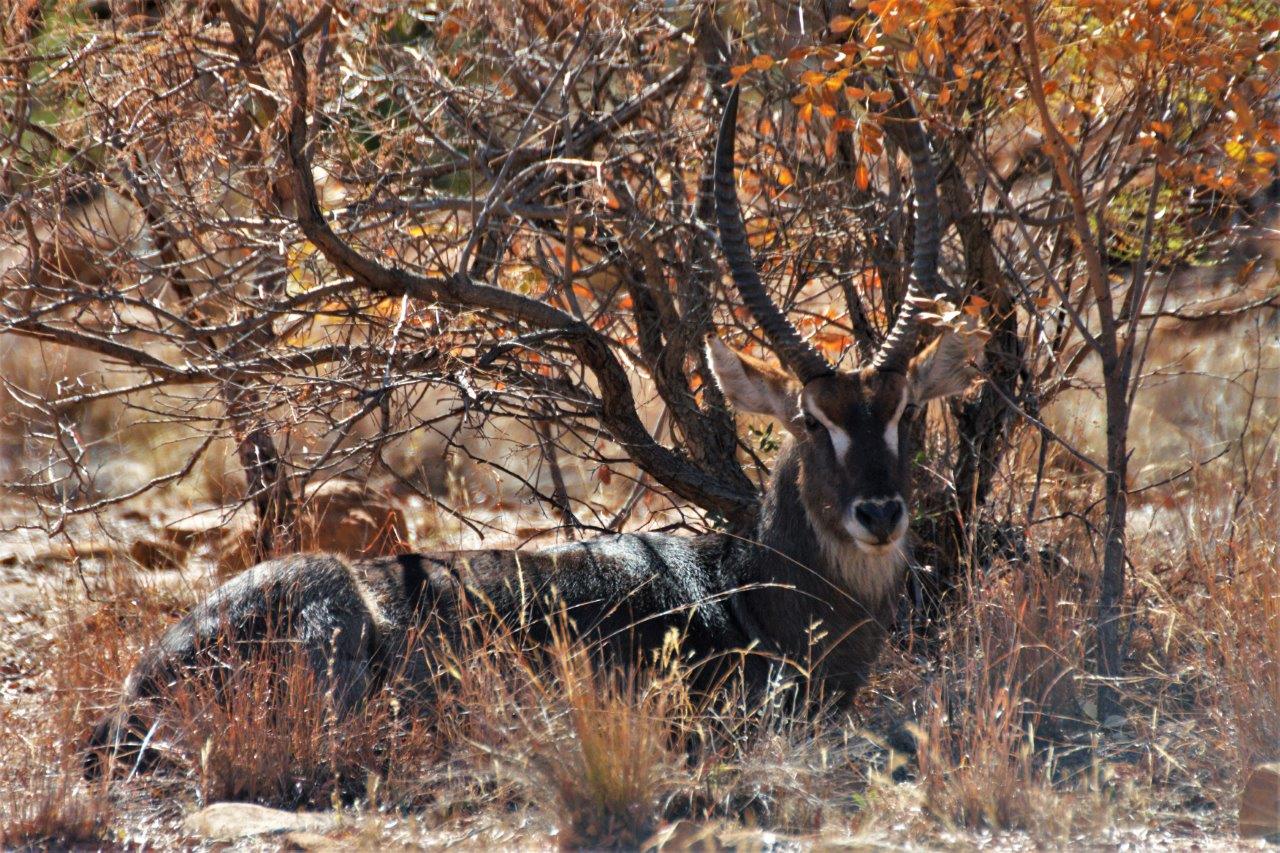
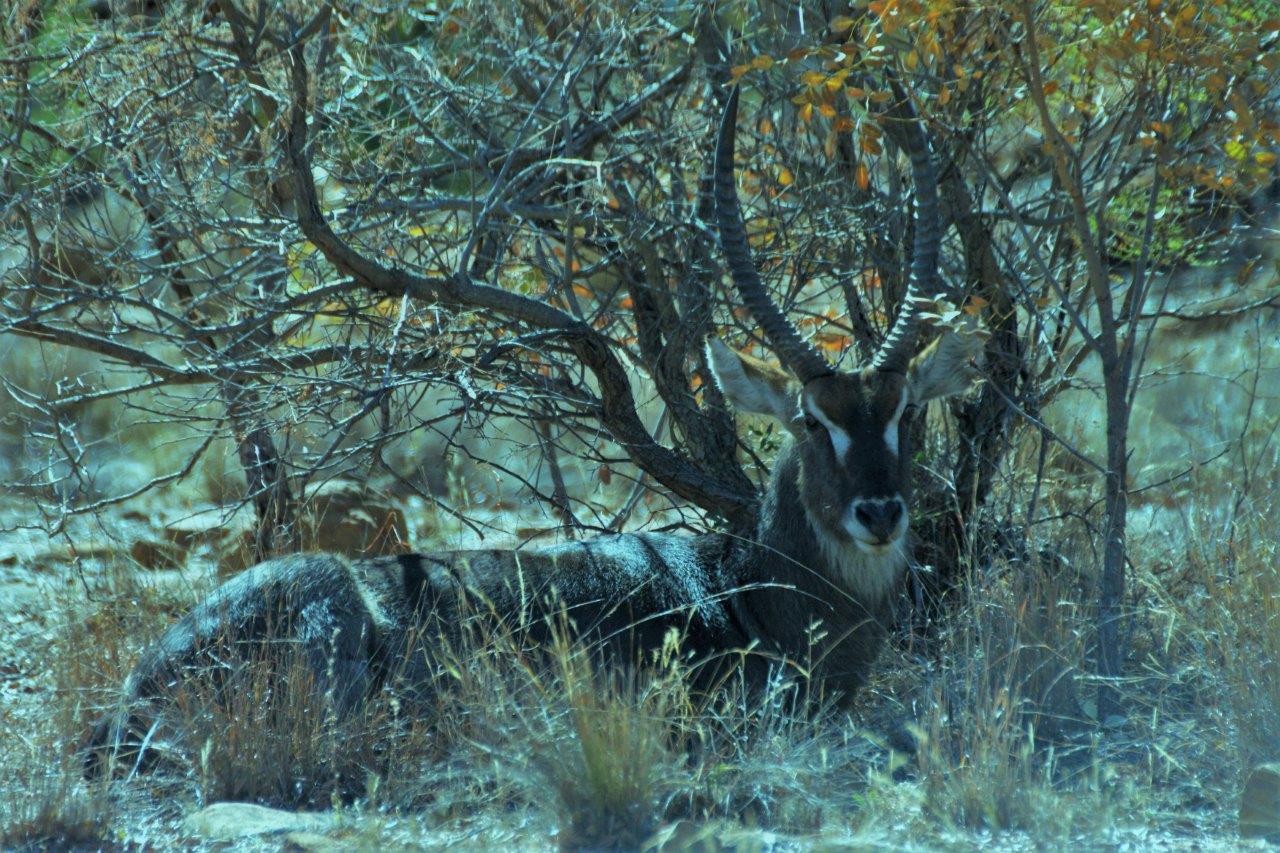 The second, Disruptive colouration. Here spots or stripes or even patterns on their coats, assist to break up the body outline, making it difficult to identify against its background. Its overall shape is disguised. Zebra in a group, referred to as a dazzle, make it difficult for predators to single out an individual when bunched together. The image of the group of Zebra at Makweti’s waterhole is modified into a Blue Green Yellow image to show how a predator could perceive the group. The ‘dazzle’ effect of the group is a great camouflage for all, but one zebra standing alone is more vulnerable and easier to select. As Zebra use the disruptive colouration of their striped bodies to avoid predators, a Leopard or Cheetah similarly uses their spots to conceal them for the hunt.
The second, Disruptive colouration. Here spots or stripes or even patterns on their coats, assist to break up the body outline, making it difficult to identify against its background. Its overall shape is disguised. Zebra in a group, referred to as a dazzle, make it difficult for predators to single out an individual when bunched together. The image of the group of Zebra at Makweti’s waterhole is modified into a Blue Green Yellow image to show how a predator could perceive the group. The ‘dazzle’ effect of the group is a great camouflage for all, but one zebra standing alone is more vulnerable and easier to select. As Zebra use the disruptive colouration of their striped bodies to avoid predators, a Leopard or Cheetah similarly uses their spots to conceal them for the hunt.
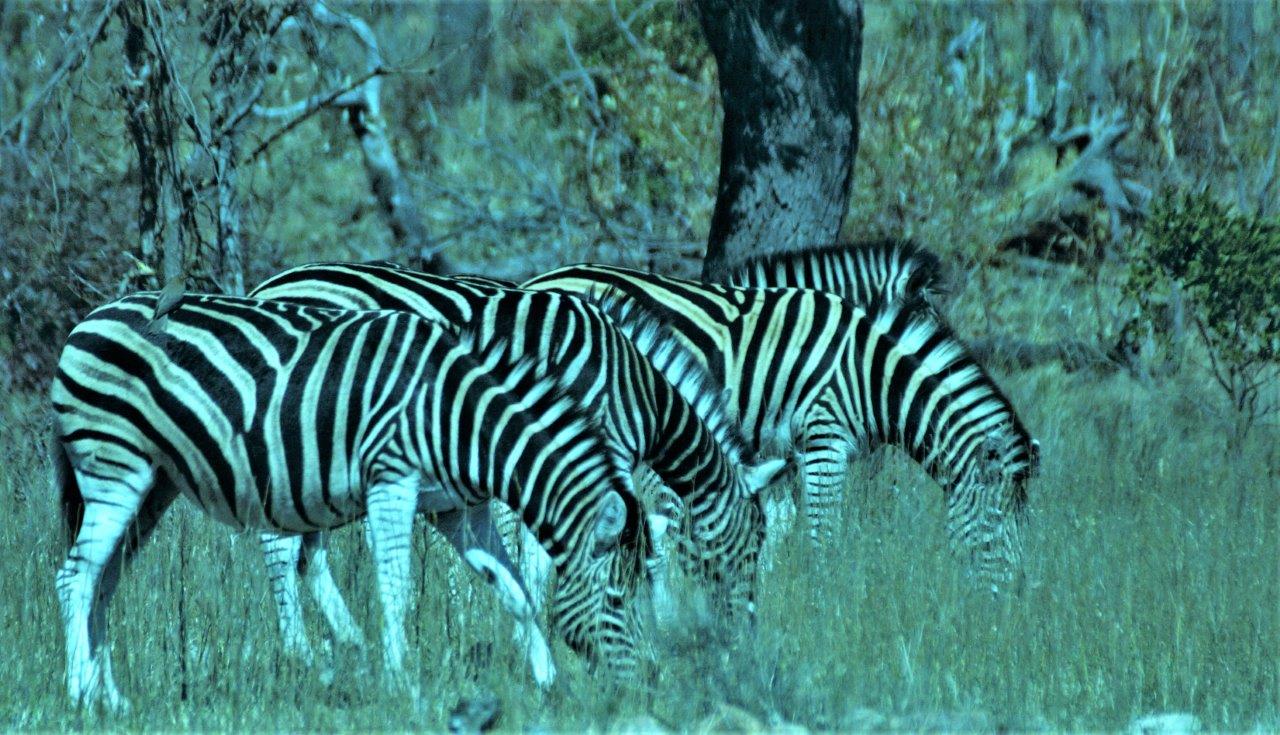
The leopard image in Colour is how we would typically see the animal in its environment, again modified to Blue Green Yellow to depict other mammals’ views. The disruptive pattern of the leopard’s coat allows it to creep within meters of its prey without being detected. Stealth, strength, flexibility, and camouflage all aid it in hunting, not to mention the cover of darkness. The ultimate predator, and most likely why it can exist in more habitat types than any other large predator on earth, including going undetected in human habitation – which is why they’re incredibly elusive on safari game drives.
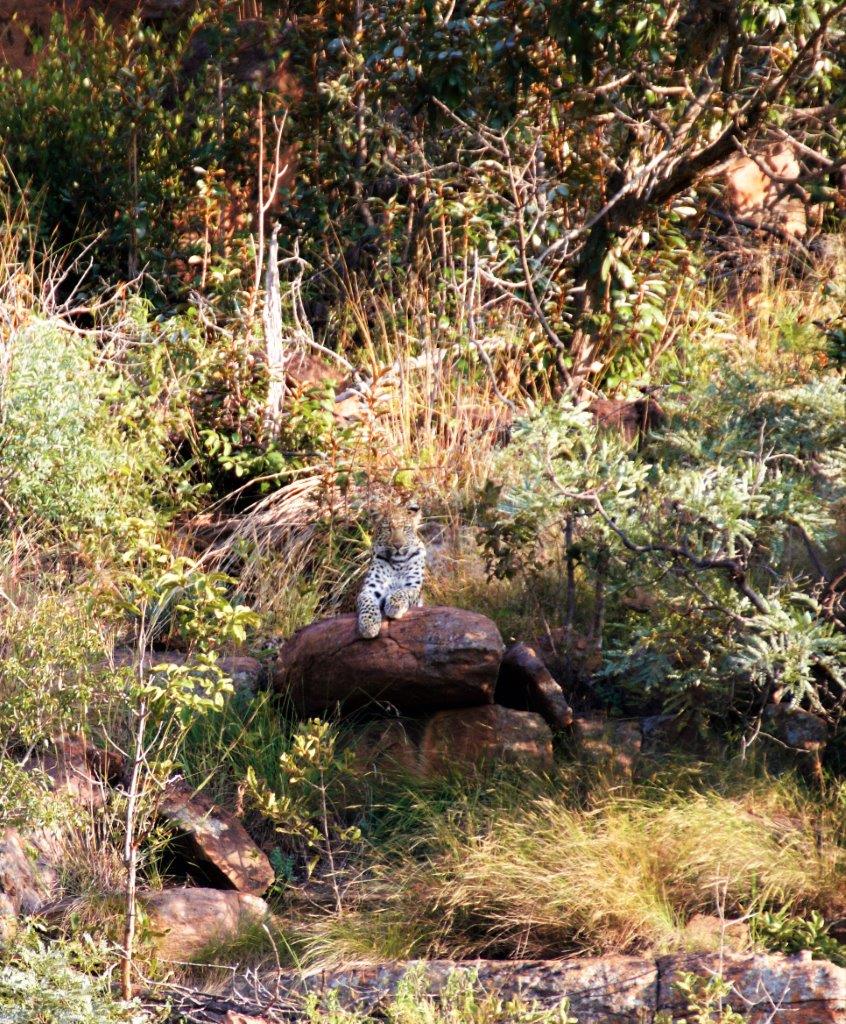
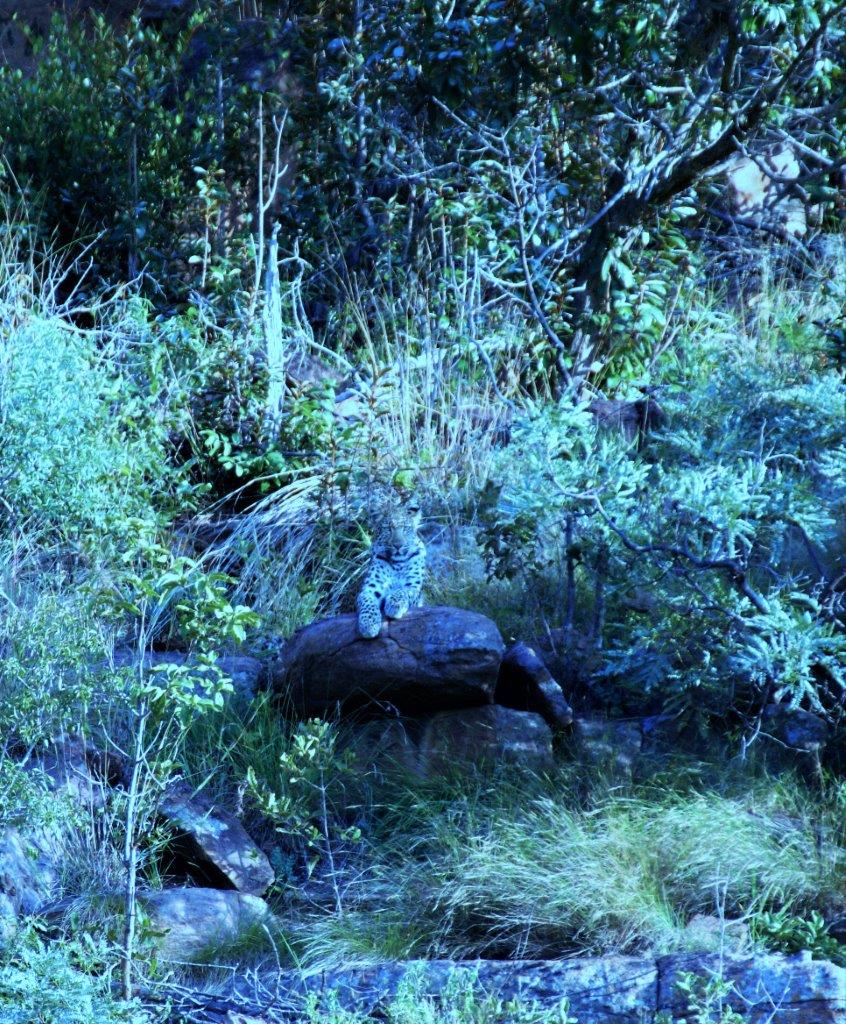
Apart from colour, or lack of, camouflage, lack of light, behaviour, or modified eye layers, mammals have other ways to remain undetected and these all aid in their survival.
We are often amazed how a four-tonne Elephant can disappear quite literally under your nose without sight or sound. See if you can spot him in the images of the hills behind the Makweti waterhole!
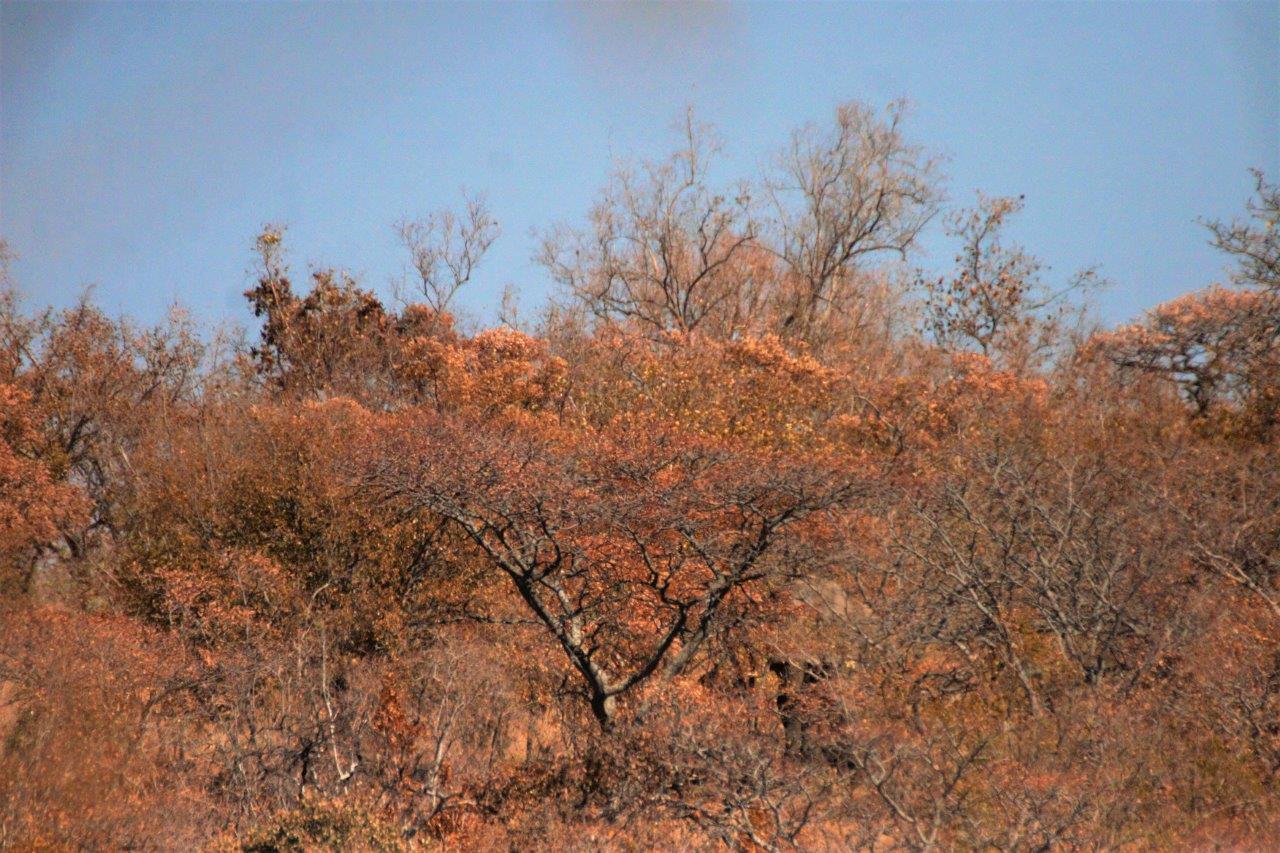
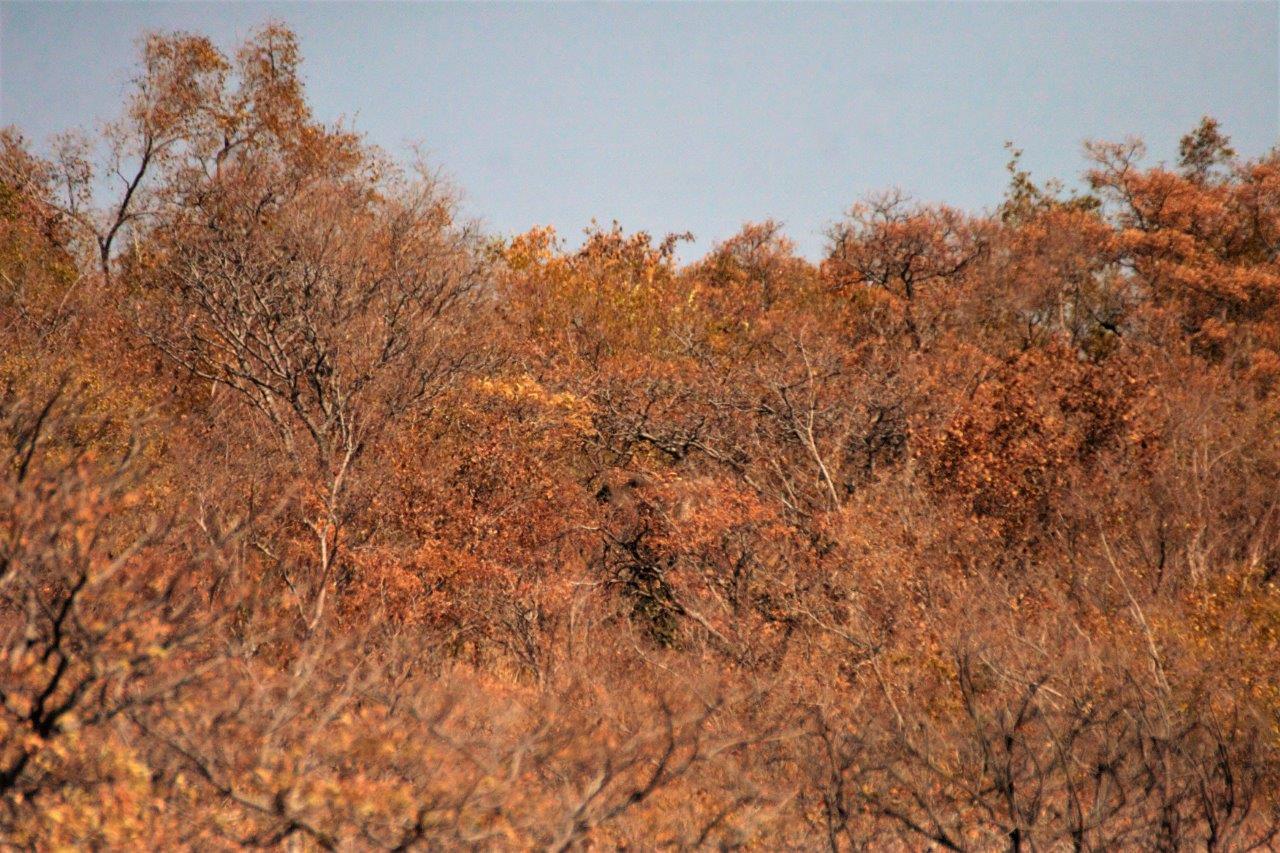
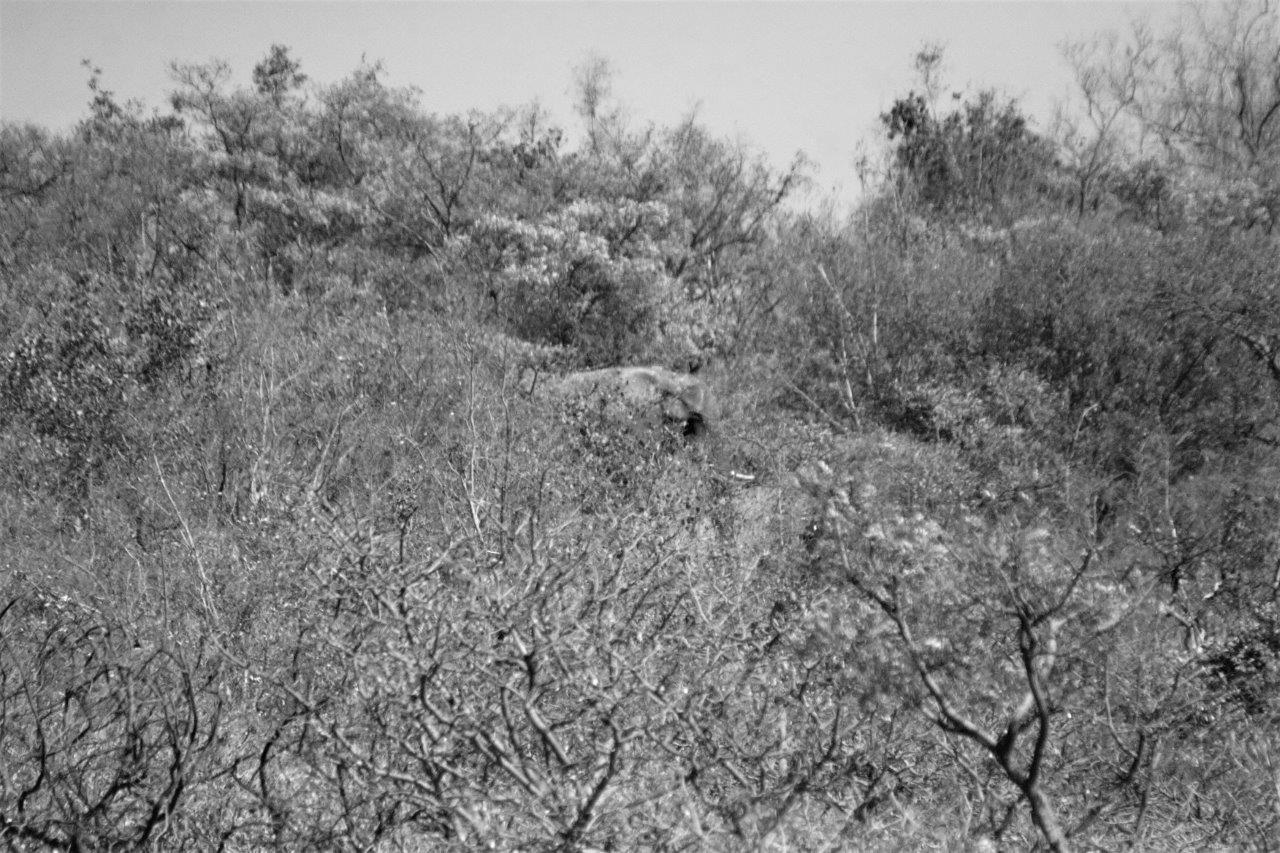
So, when you are next out and about avidly searching for an elusive animal or bird while on safari game drive, do not be so caught up on what you are looking for, remember they are trying not to be seen. Sit back and just enjoy the moment to be in the open away from your everyday existence and just Look!
Did you know?
- Some insects can see in Ultraviolet! Bees and Butterflies have four colour receptor cells to our three, allowing them to see an amazing spectrum of colours including ultraviolet. Handy for targeting the correct flowers for pollen and nectar.
- Snakes use thermal sensing to see! They see in infrared, heat, which is detected by the special pits located between the nostrils and eyes. This makes them superior when hunting in the dark.
- Some animals can see colour at night! Our colour receptors stop working under poor light conditions, but other nocturnal animals can still see colour at night. Geckos have eyes that are 350 times more sensitive to colour than ours, and they almost lack rods completely, hence they hide away during the bright daylight hours and hunt at night. Some nocturnal Lemurs have developed the ability to see shades of green at night, especially those of new shoots of leaves which form a large part of their diet.
Safari game drive content and images by:
Neil Davison
General Manager (Makweti Safari Lodge)
References:
- 30 years of personal observations by the author on various Reserves in South Africa including Welgevonden Game Reserve
- Kruger Park Adventures, C.P. de Leeuw Beyers, Living World Films, Sandton, 1960.
- Beat about the Bush – Mammals, Trevor Carnaby, First Edition, Jacana, Johannesburg, 2007.
- The Behaviour Guide to African Mammals, Richard Despard Estes, Russel Friedman Books CC, 1995.
- An introduction to the larger Mammals of Southern Africa, Joanna Dalton, Wildlife Society of Southern Africa, Natal, 1987
- Developmental Cell, Cancer Cell and I Science, Jennifer Levine – http://crosstalk.cell.com/blog/the-science-behind-animal-coloration
Colour Vision for Mice, http://colormatters.com

